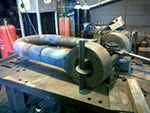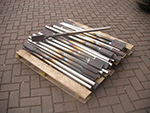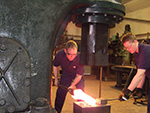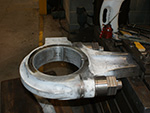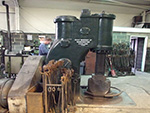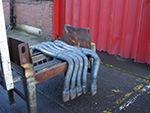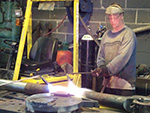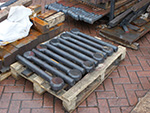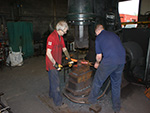Steel Forging | Hot Forming | Cold Forming
We do
- Open Die, Hammer or Smith Forging
- Drop forging.(closed die)
- Press forging
- Upset forging
- Roll forging
- Swaging
Work With
- All Steel Types including Carbon, Alloy and Stainless
- Aluminum Silicon Bronze
- Bronze
Worked for
- Components for the Oil Related Industry
- Automotive Industry
- Transportation Industry
- Ship Building Industry
- Heavy Plant Engineering Industry
- Vehicle Springs
- Steel Works Equipment
Worked On
- Anti-Roll Bars
- Automotive Leaf Springs
- Box Tongs upto 12 inches
- Bracket Work
- Davit Arms
- Engineering Parts and Repairs
- Engineering Requirements - Bolts (Off Standard)
- Forge Test Pieces
- Heat Exchanger Fabrication
- Jominy Test Pieces
- Main Leafs for Locomotives
- Open Die Forging
- Prototypes and Small Production Runs
- Shackles up to 40Kg
- Special Hooks
- Sporting Gun Parts (barrels - chop a lump)
- Torsion Bars
- more ...
Forging Steel Since 1960
Our long list of clients include:
- British Waterways
- Bridon International
- C F Booth Engineering Ltd
- Europa Engineering
- Firth Rixson Super Alloys
- MAN Diesel Ltd
- MBH Analytical Ltd
- MSI Quality Forgings
- National Railway Museum
- National Railways
- OutoKumpu Stainless Ltd
- Rotherham Metropolitan Borough Council
- Sheffield Hallam University
- Tata Steels
- Tinsley Bridge Ltd
- Wavin Pipeline Services
- William Cook
- many more ...
Forging
Virtually all metals that can be moulded / drawn out may be forged by first heating and then hammering it in to the desired shape.
A billet, wrought bar, cast or sintered ingot etc.. may be forged. Forging improves the toughness and strength by improving orientation of the metal grain structure. The repeated heating and hammering causes the metal to become more dense and the grain "flow lines" to follow the contour of the end product. Types of forgings include:
Hot Forging
Hot forging is the plastic deformation of metal at a temperature and strain rate such that recrystallization occurs simultaneously with deformation, thus avoiding strain hardening. For this to occur, high workpiece temperature (matching the metal's recrystallization temperature) must be attained throughout the process. A form of hot forging is isothermal forging, where materials and dies are heated to the same temperature. In nearly all cases, isothermal forging is conducted on superalloys in a vacuum or highly controlled atmosphere to prevent oxidation.
Cold Forging
Cold forging is a high speed manufacturing process whereby metal is shaped at room temperature often without the need for the removal of material. A simple blank is placed within a die and a punch is pressed into the blank. The blank then takes on the form of the punch and the die. By utilising multiple dies and punches in succession very complex shapes can be achieved. Metal is forced beyond its yield (elastic) limit and retains its altered shape upon removal from the die. The metal is not forced beyond its tensile strength, otherwise fracturing would occur (the exception is when trimming or piercing). Historically cold forming has been an experienced based technology, but this is changing as new computer based analytical tools are constantly being developed.
Open Die Forming
Open-die forging is also known as smith forging. In open-die forging, a hammer strikes and deforms the workpiece, which is placed on a stationary anvil. Open-die forging gets its name from the fact that the dies (the surfaces that are in contact with the workpiece) do not enclose the workpiece, allowing it to flow except where contacted by the dies. Therefore the operator needs to orient and position the workpiece to get the desired shape. The dies are usually flat in shape, but some have a specially shaped surface for specialized operations. For example, a die may have a round, concave, or convex surface or be a tool to form holes or be a cut-off tool.
Open-die forging lends itself to short runs and is appropriate for art smithing and custom work. In some cases, open-die forging may be employed to rough-shape ingots to prepare them for subsequent operations. Open-die forging may also orient the grain to increase strength in the required direction.
Cogging is successive deformation of a bar along its length using an open-die drop forge. It is commonly used to work a piece of raw material to the proper thickness. Once the proper thickness is achieved the proper width is achieved via edging. Edging is the process of concentrating material using a concave shaped open die. The process is called edging, because it is usually carried out on the ends of the workpiece. Fullering is a similar process that thins out sections of the forging using a convex shaped die. These processes prepare the workpieces for further forging processes.
Hammer Forging
The most common type of forging equipment is the hammer and anvil. Principles behind the hammer and anvil are still used today in drop-hammer equipment. The principle behind the machine is simple: raise the hammer and drop it or propel it into the workpiece, which rests on the anvil. The main variations between drop-hammers are in the way the hammer is powered; the most common being air and steam hammers. Drop-hammers usually operate in a vertical position. The main reason for this is excess energy (energy that isn't used to deform the workpiece) that isn't released as heat or sound needs to be transmitted to the foundation. Moreover, a large machine base is needed to absorb the impacts.
To overcome some shortcomings of the drop-hammer, the counterblow machine or impactor is used. In a counterblow machine both the hammer and anvil move and the workpiece is held between them. Here excess energy becomes recoil. This allows the machine to work horizontally and have a smaller base. Other advantages include less noise, heat and vibration. It also produces a distinctly different flow pattern. Both of these machines can be used for open-die or closed-die forging.
A forging press, often just called a press, is used for press forging. There are two main types: mechanical and hydraulic presses. Mechanical presses function by using cams, cranks and/or toggles to produce a preset (a predetermined force at a certain location in the stroke) and reproducible stroke. Due to the nature of this type of system, different forces are available at different stroke positions. Mechanical presses are faster than their hydraulic counterparts (up to 50 strokes per minute). Their capacities range from 3 to 160 MN (300 to 18,000 short tons-force). Hydraulic presses use fluid pressure and a piston to generate force. The advantages of a hydraulic press over a mechanical press are its flexibility and greater capacity. The disadvantages include a slower, larger, and costlier machine to operate.
Smith Forging
Forging worked between flat or simple contour dies by repeated strokes and manipulation of the workpiece. Also known as "hand" or "flat die " forging.Heavy workpieces could be processed using a smith-forging hammer, and smaller forgings are die formed in drop hammers. Smith forging hammers are typically steam or air-operated, consisting of a power actuated ram supported by a heavy cast iron frame. The final product is a result of the ram being powered into the dies containing the workpiece.
Drop Forging
Drop forging is a metal shaping process, the metal to be formed is first heated then shaped by forcing it into the contours of a die, this force can be in excess of 2000 tons. The drop forging process can be performed with the material at various temperatures.
Hot Forging
During hot forging the metals are heated to above their recrystallization temperature. The main benefit of this hot forging is that work hardening is prevented due to the recrystallization of the metal as it begins to cool.
Cold Forging
Cold Forging is generally performed with metal at room temperature below the the recrystallization temperature. Cold forging typically work hardens the metal.
There are two types of drop forging, open die and closed die.
- Open die drop forging requires the operator to position the work piece while it is impacted by the ram. The die attached to the ram is usually flat or of a simple contour, most of the shaping is achieved by the operator physically positioning the work piece before each stroke of the ram. There are also special dies which can be used to cut the metal, form holes or notches. see more
- Closed die drop forging comprises of a die on the anvil which resembles a mould, the ram which falls and strikes the top of the metal billet can also be equipped with a die. The heated metal billet is placed on the lower die while the ram drives down forcing the metal to fill the contours of the die blocks.
Press Forging
Press forging works by slowly applying a continuous pressure or force, which differs from the near-instantaneous impact of drop-hammer forging. The amount of time the dies are in contact with the workpiece is measured in seconds (as compared to the milliseconds of drop-hammer forges). The press forging operation can be done either cold or hot.
The main advantage of press forging, as compared to drop-hammer forging, is its ability to deform the complete workpiece. Drop-hammer forging usually only deforms the surfaces of the workpiece in contact with the hammer and anvil; the interior of the workpiece will stay relatively undeformed. Another advantage to the process includes the knowledge of the new part's strain rate. We specifically know what kind of strain can be put on the part, because the compression rate of the press forging operation is controlled. There are a few disadvantages to this process, most stemming from the workpiece being in contact with the dies for such an extended period of time. The operation is a time-consuming process due to the amount and length of steps. The workpiece will cool faster because the dies are in contact with workpiece; the dies facilitate drastically more heat transfer than the surrounding atmosphere. As the workpiece cools it becomes stronger and less ductile, which may induce cracking if deformation continues. Therefore heated dies are usually used to reduce heat loss, promote surface flow, and enable the production of finer details and closer tolerances. The workpiece may also need to be reheated. When done in high productivity, press forging is more economical than hammer forging. The operation also creates closer tolerances. In hammer forging a lot of the work is absorbed by the machinery, when in press forging, the greater percentage of work is used in the work piece. Another advantage is that the operation can be used to create any size part because there is no limit to the size of the press forging machine. New press forging techniques have been able to create a higher degree of mechanical and orientation integrity. By the constraint of oxidation to the outer layers of the part, reduced levels of microcracking occur in the finished part.
Press forging can be used to perform all types of forging, including open-die and impression-die forging. Impression-die press forging usually requires less draft than drop forging and has better dimensional accuracy. Also, press forgings can often be done in one closing of the dies, allowing for easy automation.
Upset Forging
Upset forging increases the diameter of the workpiece by compressing its length. Based on number of pieces produced this is the most widely used forging process. A few examples of common parts produced using the upset forging process are engine valves, couplings, bolts, screws, and other fasteners.
Upset forging is usually done in special high-speed machines called crank presses, but upsetting can also be done in a vertical crank press or a hydraulic press. The machines are usually set up to work in the horizontal plane, to facilitate the quick exchange of workpieces from one station to the next. The initial workpiece is usually wire or rod, but some machines can accept bars up to 25 cm (9.8 in) in diameter and a capacity of over 1000 tons. The standard upsetting machine employs split dies that contain multiple cavities. The dies open enough to allow the workpiece to move from one cavity to the next; the dies then close and the heading tool, or ram, then moves longitudinally against the bar, upsetting it into the cavity. If all of the cavities are utilized on every cycle then a finished part will be produced with every cycle, which makes this process advantageous for mass production.
These rules must be followed when designing parts to be upset forged:
- The length of unsupported metal that can be upset in one blow without injurious buckling should be limited to three times the diameter of the bar.
- Lengths of stock greater than three times the diameter may be upset successfully provided that the diameter of the upset is not more than 1.5 times the diameter of the stock.
- In an upset requiring stock length greater than three times the diameter of the stock, and where the diameter of the cavity is not more than 1.5 times the diameter of the stock, the length of unsupported metal beyond the face of the die must not exceed the diameter of the bar.
Swaging
Swaging is a forging process in which the dimensions of an item are altered using a die or dies, into which the item is forced. Swaging is usually a cold working process; however, it is sometimes done as a hot working process.
Roll Forging
Roll forging is a process where round or flat bar stock is reduced in thickness and increased in length. Roll forging is performed using two cylindrical or semi-cylindrical rolls, each containing one or more shaped grooves. A heated bar is inserted into the rolls and when it hits a stop the rolls rotate and the bar is progressively shaped as it is rolled through the machine. The piece is then transferred to the next set of grooves or turned around and reinserted into the same grooves. This continues until the desired shape and size is achieved. The advantage of this process is there is no flash and it imparts a favorable grain structure into the workpiece.
Examples of products produced using this method include axles, tapered levers and leaf springs.

